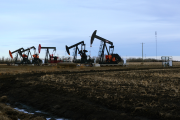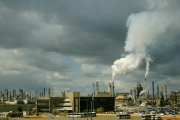The “truth of the matter,” Stephen Harper told a New York audience this week, is that heavy oil from the oilsands is no worse than heavy crudes in other parts of the world. “And I don't have to tell you there are probably reasons beyond just emissions why you would want to have your oil from Canada rather than from Venezuela.”
It’s perhaps his government’s favourite argument for the Keystone XL pipeline proposal: if you have to buy oil from someone, why not from friendly Canada?
The fact is that the greenhouse gas emissions from oilsands production compare unfavourably even to other heavy oils — Alberta’s bitumen languishes at the back of the pack no matter what it’s measured against.
But the bigger problem with Harper’s line of reasoning is his assumption that the world’s demand for oil will remain at least as voracious as it is today.
The government’s new “Go with Canada” online campaign puts it this way:
America faces a choice: It can import oil from Canada — a secure and environmentally responsible neighbor that is committed to North American energy independence — or it can choose less stable offshore sources with much weaker environmental standards.
But there is another choice we need to start considering: rather than picking favourites among the world’s petroleum producers, the U.S. could opt to use less oil.
President Obama’s vehicle fuel efficiency standards — which Canada has also adopted — take a significant step in that direction.
You won’t hear a lot of the pundits watching the Keystone decision talk about it, but the reality is that we all need to burn fewer fossil fuels if we’re going to keep global warming under control.
The International Energy Agency’s flagship publication concluded that if countries take the action needed to have a fair shot of avoiding a dangerous 2°C of global warming, the world’s demand for oil will start to fall within this decade. By 2035, they found, oil demand will be 10 per cent below today’s level.
Canada has committed to staying below the 2°C limit on global warming, so you might assume that our government would pay close attention to the IEA’s assessment, which is known as the “450 Scenario.”
But taking that prescription seriously would have significant consequences for the growth of the oil and gas sector in Canada.
While he fielded questions about climate change from his New York audience, Stephen Harper had — predictably — nothing to say about the contradiction between going all-in on oilsands expansion and avoiding dangerous climate change.In the IEA’s 450 scenario, oilsands production grows much more slowly than the industry predicts today, reaching just over 3 million barrels per day in 2035. In comparison, the Government of Alberta projects that oilsands production will reach that level by 2020, and has already approved over 5 million barrels per day of oilsands production.
While he fielded questions about climate change from his New York audience, Stephen Harper had — predictably — nothing to say about the contradiction between going all-in on oilsands expansion and avoiding dangerous climate change.
Instead, it fell to a group of scientists and climate policy experts to tell us what’s really at stake.
In an open letter to Natural Resources Minister Joe Oliver last week, they wrote:
We are not convinced that your advocacy in support of new pipelines and expanded fossil fuel production takes climate change into account in a meaningful way. Avoiding dangerous climate change will require significantly reducing our reliance on fossil fuels and making a transition to cleaner energy.
Making the tough choices
Stephen Harper did acknowledge some of the complexities of tackling climate change in his New York comments — a welcome departure from the attacks on a “job killing carbon tax” that we’re more used to hearing from him here at home. As he put it, “if we admit they're real problems with real, difficult solutions and real, difficult choices that have to be made, that everybody has to contribute to, then I think we'll make progress.”
Couldn’t agree more. But the Prime Minister has, thus far, failed to make one of those real, difficult choices: his government has yet to introduce any limits whatsoever on greenhouse gas pollution from the oil and gas sector.
Regulations that could get Canada on track to hit its 2020 target would cost less than $3 a barrel — and would help Canada’s oil and gas sector compete in a world where environmental performance matters. Strong rules would also get the attention of U.S. Secretary of State John Kerry, a long-time climate advocate who will play a critical role in the Keystone decision.
Without strong climate regulations, emissions from the oilsands are on track to double from 2010 to 2020, wiping out all the reductions that other parts of the economy are expected to make over the same time period.And in the absence of strong regulations, the oilsands — Canada’s fastest-growing source of greenhouse gas pollution — is on track to double its emissions from 2010 to 2020, wiping out all the reductions that other parts of the economy are expected to make over the same time period.
The growth in greenhouse gas pollution from the oilsands undermines another of the government’s core arguments, which is that Canada and the U.S. are working towards the same 2020 emission targets.
On paper, our countries do share a target. The difference is that credible U.S. analysts consider their target to be achievable, while no independent expert in Canada thinks we’re on track to hit ours.
In fact, Environment Canada’s latest public projections show that Canada will miss its target by more than the emissions from Saskatchewan, Manitoba and New Brunswick put together.
More than any other factor, it’s the projected growth in the oilsands that explains why Canada is headed towards failure on its 2020 climate goal while the U.S. appears to have its target within reach.More than any other factor, it’s the projected growth in the oilsands that explains why Canada is headed towards failure on its 2020 climate goal while the U.S. appears to have its target within reach.
So the most important thing Stephen Harper could do now to burnish his climate change track record is to introduce tough policies to cut the oil and gas sector’s emissions.
And in the absence of those rules, it’s no surprise that his government has struggled to show that it could be trusted with a shiny new pipeline.






